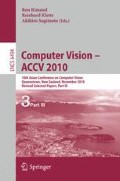Abstract
Articulated tracking of humans is a well-studied field, but most work has treated the humans as being independent of the environment. Recently, Kjellström et al. [1] showed how knowledge of interaction with a known rigid object provides constraints that lower the degrees of freedom in the model. While the phrased problem is interesting, the resulting algorithm is computationally too demanding to be of practical use. We present a simple and elegant model for describing this problem. The resulting algorithm is computationally much more efficient, while it at the same time produces superior results.
Access this chapter
Tax calculation will be finalised at checkout
Purchases are for personal use only
Preview
Unable to display preview. Download preview PDF.
References
Kjellström, H., Kragić, D., Black, M.J.: Tracking people interacting with objects. In: CVPR 2010: Proceedings of the 2010 IEEE Computer Society Conference on Computer Vision and Pattern Recognition (2010)
Poppe, R.: Vision-based human motion analysis: An overview. Computer Vision and Image Understanding 108, 4–18 (2007)
Capp, O., Godsill, S.J., Moulines, E.: An overview of existing methods and recent advances in sequential Monte Carlo. Proceedings of the IEEE 95, 899–924 (2007)
Nocedal, J., Wright, S.J.: Numerical optimization. Springer Series in Operations Research. Springer, Heidelberg (1999)
Erleben, K., Sporring, J., Henriksen, K., Dohlmann, H.: Physics Based Animation. Charles River Media, Hingham (2005)
Brubaker, M.A., Fleet, D.J., Hertzmann, A.: Physics-based person tracking using the anthropomorphic walker. International Journal of Computer Vision 87, 140–155 (2010)
Wang, J.M., Fleet, D.J., Hertzmann, A.: Gaussian Process Dynamical Models for Human Motion. IEEE Transactions on Pattern Analysis and Machine Intelligence 30, 283–298 (2008)
Sminchisescu, C., Jepson, A.: Generative modeling for continuous non-linearly embedded visual inference. In: ICML 2004: Proceedings of the Twenty-First International Conference on Machine Learning, pp. 759–766. ACM, New York (2004)
Lu, Z., Carreira-Perpinan, M., Sminchisescu, C.: People Tracking with the Laplacian Eigenmaps Latent Variable Model. In: Platt, J., Koller, D., Singer, Y., Roweis, S. (eds.) Advances in Neural Information Processing Systems, vol. 20, pp. 1705–1712. MIT Press, Cambridge (2008)
Sidenbladh, H., Black, M.J., Fleet, D.J.: Stochastic tracking of 3D human figures using 2D image motion. In: Vernon, D. (ed.) ECCV 2000. LNCS, vol. 1843, pp. 702–718. Springer, Heidelberg (2000)
Elgammal, A.M., Lee, C.S.: Tracking People on a Torus. IEEE Transaction on Pattern Analysis and Machine Intelligence 31, 520–538 (2009)
Urtasun, R., Fleet, D.J., Fua, P.: 3D People Tracking with Gaussian Process Dynamical Models. In: CVPR 2006: Proceedings of the 2006 IEEE Computer Society Conference on Computer Vision and Pattern Recognition, pp. 238–245 (2006)
Urtasun, R., Fleet, D.J., Hertzmann, A., Fua, P.: Priors for people tracking from small training sets. In: Tenth IEEE International Conference on Computer Vision, vol. 1, pp. 403–410 (2005)
Bandouch, J., Engstler, F., Beetz, M.: Accurate human motion capture using an ergonomics-based anthropometric human model. In: Perales, F.J., Fisher, R.B. (eds.) AMDO 2008. LNCS, vol. 5098, pp. 248–258. Springer, Heidelberg (2008)
Balan, A.O., Sigal, L., Black, M.J.: A quantitative evaluation of video-based 3d person tracking. Visual Surveillance and Performance Evaluation of Tracking and Surveillance, 349–356 (2005)
Hauberg, S., Sommer, S., Pedersen, K.S.: Gaussian-like spatial priors for articulated tracking. In: Daniilidis, K., Maragos, P., Paragios, N. (eds.) ECCV 2010. LNCS, vol. 6311, pp. 425–437. Springer, Heidelberg (2010)
Yamamoto, M., Yagishita, K.: Scene constraints-aided tracking of human body. In: CVPR, pp. 151–156. IEEE Computer Society, Los Alamitos (2000)
Author information
Authors and Affiliations
Editor information
Editors and Affiliations
Rights and permissions
Copyright information
© 2011 Springer-Verlag Berlin Heidelberg
About this paper
Cite this paper
Hauberg, S., Pedersen, K.S. (2011). Stick It! Articulated Tracking Using Spatial Rigid Object Priors. In: Kimmel, R., Klette, R., Sugimoto, A. (eds) Computer Vision – ACCV 2010. ACCV 2010. Lecture Notes in Computer Science, vol 6494. Springer, Berlin, Heidelberg. https://doi.org/10.1007/978-3-642-19318-7_59
Download citation
DOI: https://doi.org/10.1007/978-3-642-19318-7_59
Publisher Name: Springer, Berlin, Heidelberg
Print ISBN: 978-3-642-19317-0
Online ISBN: 978-3-642-19318-7
eBook Packages: Computer ScienceComputer Science (R0)

